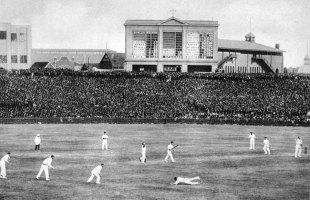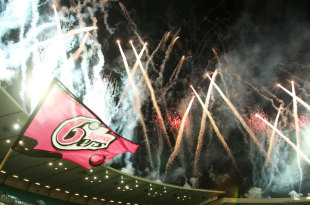100 Tests at the SCG
The heart of Sydney
The SCG, which clocks its 100th Test this week, has been a cultural hub of the city and a symbol of it like no other

| |||
Related Links
News : Clarke pays respects to his home ground
Features : In Sydney they go feet first Features : Ten memorable SCG Tests Features : The view from the other side
Teams: Australia
Grounds: Sydney Cricket Ground
| |||
As an enduring symbol of Sydney, the SCG predates the Harbour Bridge and the Opera House by a good margin. Sydney is a city in which sport, in general, and cricket in particular, have been a large part of the common culture, and for generations of devotees the grand old ground has remained its cultural hub.
There is an aura to it. The Members' Stand clock seems almost to record timelessness. From way back in 1882, when Billy Murdoch's Australians defeated England in the first two Tests played there, until the 100th this week, the ghosts of greatness have been ever-present.
My experience of the Sydney Cricket Ground dates back to the 1950s, though somehow the relationship seems a lot longer than that. For years as a young cricket writer I listened to the tales of the 1930s that Alan McGilvray would tell with relish, often over a bottle of Scotch. I shared the press box with giants like Bill O'Reilly and Jack Fingleton, whose stories of Bodyline and Bradman were irresistible.
At the top of their list of stellar SCG batting performances was the memorable effort of Stan McCabe, whose 187 not out in the first Test of the 1932-33 Ashes series resisted all that Bodyline could throw at him. Many thought it the best innings ever played at the ground. McCabe hit 25 fours in that innings, many of them hooked as the ball rocketed to him at eye level. Many thought McCabe's offensive against such lethal bowling might well have stopped the Bodyline tactic in its tracks. Sadly, it was not to be.
The Bradman era at the SCG must have been a marvellous time, when the word would go out that he was on his way to the crease, and people would flood in from all over town. Sometimes the crowd grew three- and four-fold, such was his appeal. Since then the ground has necessarily changed in its nature as well as its function. The old green-roofed stands have shrunk, as the Bob Stand, the Sheridan Stand and the old Brewongle have been enveloped by modern imperatives.
The Hill has gone, too, and with it a part of Sydney that was unique. Until the Bradman Stand went up in the 1970s there was vast open space at both ends of the ground. It was commonplace for rugs to be spread on the grass, weighed down by an Esky full of beer. When World Series Cricket came upon us in 1978, the light towers went up, to the dismay of many. People appeared in coloured clothing to play a brash new type of night cricket, and thousands flocked to watch. The objectors of 1978 would marvel at the Big Bash League today.
Night and day, the SCG was a social hub for a sporting fraternity of all persuasions. In the Members' and the Noble stands everybody seemed to know everybody. If Keith Miller wasn't holding court, grabbing each of his limitless mates as they entered, somebody else was. You were never short of a beer and a laugh and a story of great days past.
In the outer it was much the same. There was a character to the Hill that was captivating. Shirtless young men would gather in great numbers, downing beers under the benign gaze of policemen who seemed only to envy them. Occasionally they would put together a chain of beer-can ringtops that would stretch from third man to cover point. There was often a record to be chased.
To Englishmen the Hill was a bizarre place that captured the Australian nature. On one tour in the early 1970s, Brian Bearshaw of the Manchester Evening News insisted on savouring the experience, so we went up under the old scoreboard and stripped to the waist like everybody else. Bearshaw started the day a pale and ghostly white and finished it lobster red. He never ventured to the Hill again.
For much of the 20th century the SCG was the home of all of Sydney's major sports. Rugby Tests were played there. Rugby League used it as its home ground. In days when the ground was less well drained it would often be an absolute mud heap.
| Everybody seemed to know everybody. If Keith Miller wasn't holding court, grabbing each of his limitless mates as they entered, somebody else was. You were never short of a beer and a laugh and a story of great days past | |||
The Bulli soil that came from the south coast of NSW to form the SCG pitch was black and fertile, and made for famously hard wickets. But when it churned up late in the football season, as it did for some famous grand finals, there was precious little time to get it ready for the cricket. Somehow they always did.
The memories of great days remain vivid. My first experience covering cricket for the Daily Telegraph as a very young journalist was a NSW Sheffield Shield game against Queensland, when Ian Craig hit 146, Neil Harvey scored 229, and the home side was 424 for 2 at stumps on the first day. O'Neill, Thomas, Benaud, Davidson and Johnny Martin were all to follow.
This was late 1960, when Australia and West Indies were about to lock horns in the most magical Test series of all. A tie in Brisbane and thrilling contests in Melbourne and Adelaide made the series legendary, but Sydney was no less memorable thanks to an innings of 168 by the great Garfield Sobers.
To this day I have in my mind's eye one shot in that innings that remains indelible. Ian Meckiff was hurling them down at great pace from the Paddington end. Sobers went on to the back foot, stood tall with one leg raised, and punched him on to the concourse between the Paddington Hill and the old Sheridan stand for six. I haven't seen better in the 50 years since.
Through the 1960s and into the 1970s, Doug Walters was a perennial SCG favourite, as much for the way he played as for the results he achieved. They named a stand in his honour - at first unofficial, as a measure of the crowd's affection for him, and later official - and the ground lit up whenever he was at the crease.
He scored 242 and 103 in the fifth Test against West Indies in 1969, in his most productive home performance after Australia had been put in to bat. It stood in stark contrast to his captain, Bill Lawry, whose first-innings 151 took over eight hours. Lawry also refused to enforce the follow-on despite a first-innings lead of 340, then pushed the match into a sixth day by leaving West Indies 735 to score in the final innings. Australia won the Test by 382 runs, and thus the series.
One of the more dramatic days at the SCG came during the hastily arranged seventh Test of 1970-71, when the formidable English fast bowler John Snow caught the Australian tailender Terry Jenner on the head with a bouncer. These were days before helmets, and bowling bouncers at tailenders was considered poor form. When Snow was within range of the fence at the Paddington End, a spectator grabbed him in retribution. The England captain, Ray Illingworth, was furious as beer cans rained on to the field; he took his players off and left batsmen Greg Chappell and Jenner standing forlornly at the wicket.
Illingworth had taken his action without the permission of the umpires, technically forfeiting the match as the recently retired No. 1 umpire Colin Egar was happy to tell everybody in the Noble bar. Furious negotiations in the dressing room got them all back on the field and England went on to win a Test that, had people reacted differently, might well have been taken from them.

| |||
The ground has seen much more high drama over its 100 Tests. Through the eras of Lillee and Marsh, Border and Taylor, Warne and McGrath, Waugh and Ponting, the cavalcade of superstars has continued to leave an indelible mark on a remarkable ground. The great Brian Lara made his first appearance there as a 23-year-old in January 1993, and made 277 runs in classical fashion before being run out. The game was drawn, but a new young champion of extraordinary talent had announced himself.
The football codes, too, have offered plenty down the years. In 1965, nearly 80,000 people somehow got into the ground for a Rugby League grand final. They perched themselves on the roof of the old Bob Stand and anywhere else they could find a spot. It was scary stuff.
The Sydney Cricket Ground will see many more great days. It is a space that has always been central to the character of Sydney. That is not likely to change
.
.

No comments:
Post a Comment